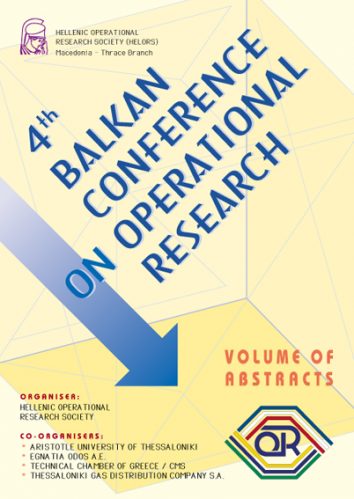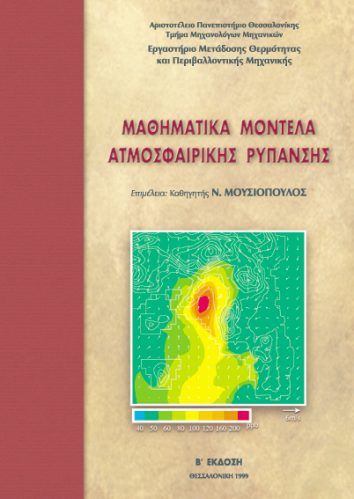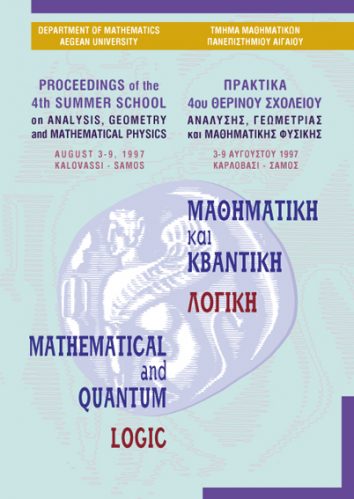
Preface by: Elias Beriatos / Evangelos Livieratos
Wandering over the chart of the Mediterranean Sea our eyes and mind are usually moving along a geographic parallel, perhaps due to specific human geo-perception, which tends to follow instinctively the direction of the earth’s rotation! Or perhaps it is the very longitudinal shape of the Sea itself, which constrains mental navigation into an east or west perspective and captures interest.
But a less relaxed and more careful observation of the whole shows a particular geographical articulation of the Mediterranean where two regional transversal seas, the Aegean and the Adriatic-Ionian, interrupt northwards its longitudinal continuity. One of these «secondary» Mediterranean seas, the Aegean, was more generously treated by History and Geography than the other one, the Adriatic-Ionian Sea, as international bibliography confirms.
This publication focuses on the importance of the less studied Adriatic-Ionian Sea intending to revisit this ancient meridian wise long water continuum which connects a resplendent metropolis like Venice with tiny mysterious isles like the Homeric Strofades. This water continuum is bounded by a narrow curved coast that today brings face to face numerous cultural heritages distributed in seven states and many more regions all of which are anxious to establish a many-faceted network for cooperation in peace and progress. The sea links up two very major solid-land and water-land geographical areas. Two areas with literally central importance for Europe as the German terms Mitteleuropa and Mittelmeer fittingly indicate.
The volume is dedicated to the Adriatic-Ionian Sea as a complex of historic reflections, spatial representations, human adventures and future fortunes. Essays mainly on History, Geography, Cartography, Socio-Economics and Technologies written by prominent personalities from politics, sciences, and arts intend to bring on stage this special European sea, its role in space and time and its perspective in the new European architecture within the domain of a modern information and communication society.
The contributions, mainly by authors rooted in and influenced by the Adriatic-Ionian Sea are collected in four parts at first sight independent of each other but, at a second reading, intensely interrelated. The Vision of an optimistic future perspective is given by Elias Beriatos at the very beginning. His idea of a modern network-structured region, which takes full advantage of the unifying Sea, is founded on new European strategy on such topic.
Echoes of a complex but rich History, confused but multiform, unbalanced and turbulent but colourful and potential, strongly influenced by external impulses of power but promising a unique future proper development, are reflected in the second part of the book. The paper by J. B. Trumper treats the Greek long-term perspective of the Calabrian hydronymy as an important aquatic variant of historic toponymy. Ivo Babic delves deep and in a masterly fashion into ancient history of the maritime Adriatic-Ionian space searching for its roots and George Moschopoulos unveils the little known Greek presence on the east Adriatic coasts during the dark period for Greeks that is from the 16th to 18th centuries. Two papers by Ioanna Steriotou and Nikos Lianos treat the splendid Venetian defensive architecture along the east Adriatic and the Ionian coasts and, last but not least, the former Prime Minister of Greece, George Rallis, underlines the importance of the geographic position of Eptanesos for Hellenism in slavery.
There are no Geography and History without Maps. This axiom holds good also for the Adriatic – Ionian Sea on any scale: Camillo Tonini narrates the 18th century navigation between the Adriatic and Ionian illustrated in Tentivo’s portolan, Ilija Lalosevic focuses the interest on the local representations of the singular and historic fjord of Kotor and Evangelos Livieratos gives a cartographic overview of the region, with emphasis on its insular component, from Ptolemy to the medieval nautical charts of the Portolan type and from the renaissance isolaria to the dawn of scientific mapping and today’s depictions.
Routes, is the land and sea spatial nervous system of a region, connecting places and human activities. Broken routes bring isolation and pain, open routes are carriers of understanding and prosperity. Maria Kalantzopoulou examines transport and politics in the Balkans during the painful 18th and 19th centuries while Dragan Sicic, Ivan Franciskovic and Ana Peric bring transport systems to the 21st century expectations in terms of modern technology reverting in this way to the notion of the Adria – Ionian social networks treated as the Vision at the very beginning of the volume.
This collective volume is dedicated to the «many-faceted» Adrionian, the sea which brought together some of the less developed and most complicated areas in the whole of Europe, sustaining however, areas which underwent a long lasting, often painful, always intriguing, sometimes confusing, itinerary in History, however, at the same time, rich in potential and energy working for a better future within the framework of a new European political and economic architecture.
We sincerely hope that this book will be the starting of a broader discussion on the impact Adrionian could have in the design and implementation of a new development policy in the digital era of our European and Mediterranean Civilization.
We are indebted to the authors of the papers collected here for their indeed valuable and kind contribution. Special thanks are due to the Aristotle University of Thessaloniki Research Committee, to the Cephalonia – Ithaca Foundation and to the Hellenic National Centre for Maps and Cartographic Heritage – National Map Library for their support and assistance.
Πρόλογος των: Ηλία Μπεριάτου / Ευάγγελου Λιβιεράτου
Περιπλανώμενοι στον χάρτη της Μεσογείου το βλέμμα και ο νους μας κινούνται συνήθως κατά μήκος ενός γεωγραφικού παράλληλου, ίσως λόγω της γεω-αντιληπτικότητάς μας, η οποία τείνει από ένστικτο να ακολουθεί τη διεύθυνση της περιστροφής της γης! Ή ίσως να έλκει το ενδιαφέρον μας το επιμήκες σχήμα της, το οποίο καθοδηγεί τις νοητές πλεύσεις μας στα ανατολικά ή στα δυτικά.
Μια πιο προσεκτική όμως παρατήρηση της Μεσογείου κατά το όλον της, δείχνει μια ιδιαίτερη γεωγραφική συνάρθρωση, όπου δύο περιφερειακές έγκάρσιες θάλασσες, το Αιγαίο και η Αδριατική με το Ιόνιο, διακόπτουν κατά τη βόρεια έννοια, την επιμήκη συνέχειά της. Όμως μόνο η μια από αυτές τις «δευτερεύουσες» θάλασσες, το Αιγαίο, έτυχε μεγαλύτερης γενναιοδωρίας από την Ιστορία και την Γεωγραφία απ’ ότι η άλλη, η Αδριατική με το Ιόνιο, όπως μπορεί να πιστοποιηθεί από τη διεθνή βιβλιογραφία.
Η έκδοση αυτή, εστιάζεται στη σπουδαιότητα της λιγότερο μελετημένης θάλασσας, της Αδριατικής με το Ιόνιο, και αποσκοπεί να ξαναδεί αυτό το αρχαίο κατά μεσημβρινό θαλάσσιο συνεχές, το οποίο συνδέει ένδοξες μητροπόλεις, όπως η Βενετία, με νησίδες όπως οι ομηρικές Στροφάδες και το οποίο οριογραφείται από μια στενή κατά πλάτος ακτογραμμή που φέρνει σήμερα πρόσωπο με πρόσωπο πολλές πολιτιστικές κληρονομιές κατανεμημένες σε έξι κράτη και πολύ περισσότερες περιφέρειες, με τη φιλοδοξία της εγκαθίδρυσης ενός πολύπτυχου ειρηνικού και προοδευτικού δικτύου συνεργασίας. Της θάλασσας που συνδέει δύο εξαιρετικά σπουδαίες ηπειρωτικές και θαλάσσιες περιοχές, δύο περιοχές με κυριολεκτικά κεντρική σημασία για την Ευρώπη, οι οποίες προσφυώς αναφέρονται στη γερμανική γλώσσα ως Mεσευρώπη (Μitteleuropa) και Μεσόγειος (Mittelmeer).
Τα κείμενα, κυρίως ιστορικά, γεωγραφικά, κοινωνικο-οικονομικά, τεχνολογικά και διπλωματικά, γράφονται από διακεκριμένους πανεπιστημιακούς, επιστήμονες και ερευνητές, οι οποίοι φωτίζουν αυτήν την ιδιαίτερη ευρωπαϊκή – μεσογειακή θάλασσα, το ρόλο της μέσα στο χώρο και το χρόνο και την προοπτική της στη νέα ευρωπαϊκή σκηνή, στο περιβάλλον της σύγχρονης Κοινωνίας της Πληροφορίας, συμπλέκοντας την προς νότο θαλάσσια ανάσα της ευρωπαϊκής Δύσης και Ανατολής.
Τα επιμέρους κείμενα που περιέχονται στον τόμο, προέρχονται από συγγραφείς οι οποίοι είτε έχουν τις ρίζες τους στις περιοχές της Αδριατικής και του Ιονίου είτε έχουν επιρεαστεί από τον πολιτισμό τους. Οι εργασίες εντάσσονται σε τέσσερα ανεξάρτητα, σε πρώτη ματιά, μέρη που όμως αλληλοσυνδέονται σε μια δεύτερη ανάγνωση. Το Όραμα ενός αισιόδοξου μέλλοντος δίνεται από τον Ηλία Μπεριάτο στην αρχή του τόμου. Η ιδέα του για μια σύγχρονη περιοχή δικτυακά δομημένη που να εξαντλεί τα πλεονεκτήματα που προσφέρει η ενοποιητική δύναμη της κοινής θάλασσας, θεμελιώνεται με αναφορά στη νέα ευρωπαϊκή στρατηγική πάνω στο θέμα αυτό.
Η Ηχώ μιας πολύπλοκης μα συνάμα πλούσιας Ιστορίας, συγκεχυμένης αλλά και πολύμορφης, αστάθμητης και αναταρακτικής αλλά και πολύχρωμης και δυναμικής, επηρεασμένης από εξωτερικούς παλμούς ισχύος αλλά και υποσχόμενης ένα ίδιον αναπτυξιακό μέλλον, αντανακλάται στο δεύτερο μέρος του βιβλίου. Ο J. B. Trumper ασχολείται με τη βαθειά πίσω στο χρόνο προοπτική των ελληνικών υδρονυμίων της Καλαβρίας, μιας σπουδαίας «υδρικής» παραλλαγής των ιστορικών τοπωνυμίων. Ο Ivo Babic διεισδύει στην αρχαία και μεγαλιώδη ιστορία του θαλάσσιου χώρου της Αδριατικής και του Ιονίου αναζητώντας τις ρίζες του και ο Γιώργος Μοσχόπουλος αποκαλύπτει τη λίγο γνωστή ελληνική παρουσία στις ανατολικές ακτές της Αδριατικής κατά τη σκοτεινή για τους Έλληνες περίοδο της Ιστορίας τους κατά τον 16ο μέχρι τον 18ο αι. Δύο κείμενα από την Ιωάννα Στεριώτου και τον Νίκο Λιανό ασχολούνται με την ένδοξη αμυντική αρχιτεκτονική της Βενετίας κατά μήκος των ανατολικών ακτών της Αδριατικής και του Ιονίου και τέλος ο Κερκυραίος ευπατρίδης πρώην πρωθυπουργός Γεώργιος Ράλλης υπογραμμίζει τη σημασία και σπουδαιότητα της γεωγραφικής θέσης της Επτανήσου για τον σκλαβωμένο Ελληνισμό.
Δεν υπάρχει Γεωγραφία και Ιστορία χωρίς Χάρτες. Το αξίωμα ισχύει και για την Αδριο-Ιόνια θάλασσα, σε κάθε κλίμακα. Εδώ, ο Camillo Tonini διηγείται μέσα από τον πορτολάνο του Tentivo τη ναυσιπλοΐα μεταξύ της Αδριατικής και του Ιονίου κατά τον 18ο αι., ο Ilija Lalosevic εστιάζει το ενδιαφέρον του στις τοπικές απεικονίσεις του ακτογραμμικά ιδιόμορφου και ιστορικού μαυροβούνιου φιόρδ του Kotor και ο Ευάγγελος Λιβιεράτος δίνει μια χαρτογραφική άποψη της περιοχής, με έμφαση στη νησιωτική της συνιστώσα, από τον Πτολεμαίο στους μεσαιωνικούς ναυτικούς χάρτες και από τα αναγεννησιακά νησολόγια μέχρι την αυγή της επιστημονικής χαρτογραφίας και τις σημερινές απεικονίσεις.
Οι Δρόμοι είναι το χωρικό νευρικό σύστημα μιας περιοχής στην ξηρά και την θάλασσα, συνδέοντας τόπους και ανθρώπινες δραστηριότητες. Αποκομμένοι δρόμοι φέρνουν την απομόνωση και τον πόνο. Ανοιχτοί δρόμοι είναι φορείς κατανόησης και ευημερίας. Η Μαρία Καλαντζοπούλου εξετάζει τις μεταφορές και την πολιτική στα Βαλκάνια κατά τους πικρούς 18ο και 19ο αι. ενώ οι Dragan Cisic, Ivan Fransiskovic και Ana Peric φέρνουν τα συστήματα των μεταφορών στις προσδοκίες του 21ου αι., με τους όρους της νέας τεχνολογίας, συναντώντας έτσι την έννοια των δικτύων της Αδριατικής και του Ιονίου όπως αναπτύχθηκαν στο Όραμα της αρχής του τόμου!
Η συλλογική αυτή εργασία αφιερώνεται στο πολύπτυχο «Αδριόνιο», τη θάλασσα που φέρνει μαζί μερικές από τις λιγώτερο ανεπτυμένες και και τις πιο πολύπλοκες περιοχές της Ευρώπης, οι οποίες υπέφεραν μακροχρόνιες πικρές, περιπλεγμένες και συγκεχυμένες ιστορικές διαδρομές, αλλά ταυτόχρονα πλούσιες σε δυναμισμό για ένα καλύτερο μέλλον στο πλαίσιο μιας νέας ευρωπαϊκής πολιτικής και οικονομικής αρχιτεκτονικής.
Ελπίζουμε ο τόμος αυτός να είναι η αφετηρία για μια ευρύτερη συζήτηση σχετικά με τη σημασία που θα μπορούσε να έχει το σύστημα Αδριατική – Ιόνιο, στο σχεδιασμό και την εφαρμογή μιας νέας αναπτυξιακής πολιτικής στην ψηφιακή περίοδο του Ευρωπαϊκού και Μεσογειακού μας Πολιτισμού.
Το βιβλίο θα ήταν αδύνατο να συνταχθεί χωρίς την πολύτιμη και ευγενική συμμετοχή των συγγραφέων των κειμένων, διακεκριμένων προσωπικοτήτων στο χώρο τους. Τους ευχαριστούμε όλους θερμά, μαζί με την Επιτροπή Ερευνών του Αριστοτελείου Πανεπιστημίου Θεσσαλονίκης, το Ίδρυμα Κεφαλονιάς – Ιθάκης και το Εθνικό Κέντρο Χαρτών και Χαρτογραφικής Κληρονομιάς – Εθνική Χαρτοθήκη για τη συνδρομή και υποστήριξή τους.
Contents
- Preface
Elias Beriatos and Evangelos Livieratos: Adria-Ionian extrema – proxima: From an ancient sea to a modern network - Πρόλογος
Ηλίας Μπεριάτος και Ευάγγελος Λιβιεράτος: Ακρότατα–εγγύτατα της Αδριατικής και του Ιονίου: Από την αρχαία θάλασσα στα σύγχρονα δίκτυα - Visions
Elias Beriatos: Adrionian space: A new area of transnational coope-ration in Central Mediterranean - Echoes
J. B. Trumper: Greek Naiads amongst the Brettii, Oscan Naiads in Greek colonies: Calabrian hydronymy, a long term perspective and intra Mediterranean comparisons
Βαγγέλης Δ. Πανταζής: Η Ομηρική Ζάκυνθος: Οι «ιερές» Εχίνες και το μυστήριο του χαμένου Δουλιχίου
Vangelis D. Pantazis: The Homeric Zakynthos: The “sacred” Echines and the mystery of the lost Doulichion
Ivo Babic: La rotta Adriatico-Ionica, antichissima magistrale marittima
Γεώργιος Ν. Μοσχόπουλος: Ελληνικές και Σλαβικές παροικίες στις ανατολικές ακτές της Αδριατικής (16ος-18ος αι.)
Georgios N. Moschopoulos: Greek and Slavic Communities in the East Adriatic Coasts (16th-18thce.)
Νίκος Λιανός: Το θαλάσσιο κράτος της Βενετίας και η παράκτια μνημειακή αρχιτεκτονική στην Αδριατική
Nikos Lianos: The sea state of Venice and the coastal monumental architecture in Adriatic
Ιωάννα Θ. Στεριώτου: Η Άμυνα της Βενετίας στο Ιόνιο κατά την εκστρατεία του Francesco Morosini (1684-1697): Τα φρούρια των νησιών και η στρατηγική σημασία των θαλάσσιων διαδρόμων προς την ηπειρωτική ακτή
Ioanna Steriotou: The defence of Venice in the Ionian during the Francesco Morosini’s expedition (1684-1697): The castles of the islands and the strategic importance of the sea routes to the continental coast
Γεώργιος I. Ράλλης: Η σημασία της γεωγραφικής θέσεως της Επτανήσου για τον υπόδουλο Ελληνισμό
Georgios I. Rallis: The importance of the geographical position of Eptanesos for Hellenism in slavery - Maps
Camillo Tonini: In navigazione tra Adriatico e Ionio: il portolano di Gasparo Tentivo
Ilija Lalosevic: Venetian collections of maps and drawings of Kotor from 16th to 18th century
Evangelos Livieratos: On some cartographic representations of the Ardiatic – Ionian sea - Routes
Maria Kalantzopoulou: Transport and politics in the Balkans: 18th and 19th centuries
Dragan Cisic, Ivan Franciskovic, Ana Peric: Using social networks to measure transport system: The Adria – Ionian region case




